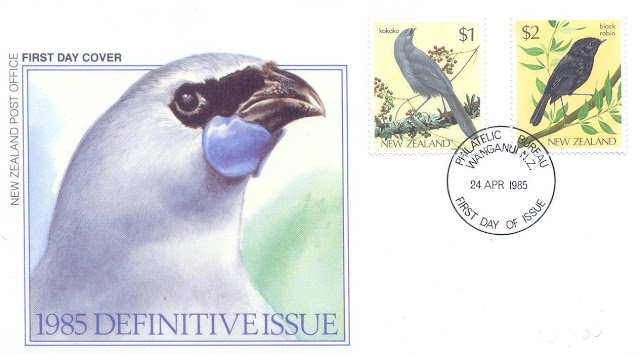The two stamps featured on this FDC are part of a set of ten such stamps issued as definitives on 24thApril,1985. Thank you Maria for this pretty FDC.
The native birds featured on this series of stamps are among the rarest and most beautiful in the world. While imported predators and destruction of their native habitats threaten their extinction, concerned New Zealanders are acting to ensure the survival of these elegant and engaging bush-residents. It is becoming increasingly difficult to find and view in the wild, the unique beauty of New Zealand's native birds which have been captured on these stamps.
This series of stamps was issued progressively over a four year period 1985 - 89.
Kokako: Issued 24 April 1985 - $1.00
The kokako (Callaeas cinerea) illustrated is a North Island variety and is also known as the blue wattled crow, referring to the two blue bags which hang from the head of the bird and steel-grey plumage. The kokako grows to about 38 cm long. With two legs and a disproportionately long tail, it is not a good flier but tends to hop along branches and trunks and glide from one tree to another or move across the forest floor with a clumsy bounding gait. Living in dense pockets of kauri trees and rain forest, the kokako is usually well away from the sight of man feeding on young leaves, flowers and berries. The North Island kokako is now quite rare - barely surviving its orange-wattled South Island cousins, considered today to be extinct.
The kokako (Callaeas cinerea) illustrated is a North Island variety and is also known as the blue wattled crow, referring to the two blue bags which hang from the head of the bird and steel-grey plumage. The kokako grows to about 38 cm long. With two legs and a disproportionately long tail, it is not a good flier but tends to hop along branches and trunks and glide from one tree to another or move across the forest floor with a clumsy bounding gait. Living in dense pockets of kauri trees and rain forest, the kokako is usually well away from the sight of man feeding on young leaves, flowers and berries. The North Island kokako is now quite rare - barely surviving its orange-wattled South Island cousins, considered today to be extinct.
Black Robin: Issued 24 April 1985 - $2.00
One of the world's rarest birds, the Chatham Islands black robin (Petroica traversi), is a forest and scrub dweller of about 16cm in length. This species is one of the smallest in numbers and most endangered in the world and during the summer of 1976/77 the New Zealand Wildlife Service transferred the entire population from Little Mangere Island to nearby Mangere Island (in the Chatham Islands group) after planting 150,000 trees in an effort to rejuvenate the habitat. In 1980/81, the first clutches of the remaining birds were transferred to nearby nests of Chatham Island warblers, where three chicks were raised to fledging by the warblers before being returned to the robins for rearing.
One of the world's rarest birds, the Chatham Islands black robin (Petroica traversi), is a forest and scrub dweller of about 16cm in length. This species is one of the smallest in numbers and most endangered in the world and during the summer of 1976/77 the New Zealand Wildlife Service transferred the entire population from Little Mangere Island to nearby Mangere Island (in the Chatham Islands group) after planting 150,000 trees in an effort to rejuvenate the habitat. In 1980/81, the first clutches of the remaining birds were transferred to nearby nests of Chatham Island warblers, where three chicks were raised to fledging by the warblers before being returned to the robins for rearing.

No comments:
Post a Comment